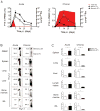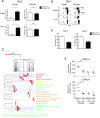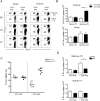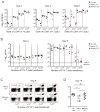Tight regulation of memory CD8(+) T cells limits their effectiveness during sustained high viral load
- PMID: 21856186
- PMCID: PMC3241982
- DOI: 10.1016/j.immuni.2011.05.017
Tight regulation of memory CD8(+) T cells limits their effectiveness during sustained high viral load
Abstract
To design successful vaccines for chronic diseases, an understanding of memory CD8(+) T cell responses to persistent antigen restimulation is critical. However, most studies comparing memory and naive cell responses have been performed only in rapidly cleared acute infections. Herein, by comparing the responses of memory and naive CD8(+) T cells to acute and chronic lymphocytic choriomeningitis virus infection, we show that memory cells dominated over naive cells and were protective when present in sufficient numbers to quickly reduce infection. In contrast, when infection was not rapidly reduced, because of high antigen load or persistence, memory cells were quickly lost, unlike naive cells. This loss of memory cells was due to a block in sustaining cell proliferation, selective regulation by the inhibitory receptor 2B4, and increased reliance on CD4(+) T cell help. Thus, emphasizing the importance of designing vaccines that elicit effective CD4(+) T cell help and rapidly control infection.
Copyright © 2011 Elsevier Inc. All rights reserved.
Figures






Comment in
-
When the going gets tough, memory T cells check out.Immunity. 2011 Aug 26;35(2):158-60. doi: 10.1016/j.immuni.2011.08.006. Immunity. 2011. PMID: 21867925
-
Study sheds further light on the immune response to chronic infections: new findings could help in the design of vaccines and therapeutics against chronic infection.Expert Rev Vaccines. 2011 Oct;10(10):1368. Expert Rev Vaccines. 2011. PMID: 22102989 No abstract available.
-
Memory T cells: new insights into the molecular basis of sensitivity and heterogeneity.Am J Transplant. 2012 Jun;12(6):1361. doi: 10.1111/j.1600-6143.2012.04151.x. Am J Transplant. 2012. PMID: 22642469 No abstract available.
References
-
- Ahmed R, Gray D. Immunological memory and protective immunity: understanding their relation. Science. 1996;272:54–60. - PubMed
-
- Appay V, Douek DC, Price DA. CD8+ T cell efficacy in vaccination and disease. Nat Med. 2008;14:623–628. - PubMed
-
- Badovinac VP, Messingham KA, Hamilton SE, Harty JT. Regulation of CD8+ T cells undergoing primary and secondary responses to infection in the same host. J Immunol. 2003;170:4933–4942. - PubMed
Publication types
MeSH terms
Substances
Associated data
- Actions
Grants and funding
LinkOut - more resources
Full Text Sources
Other Literature Sources
Molecular Biology Databases
Research Materials

